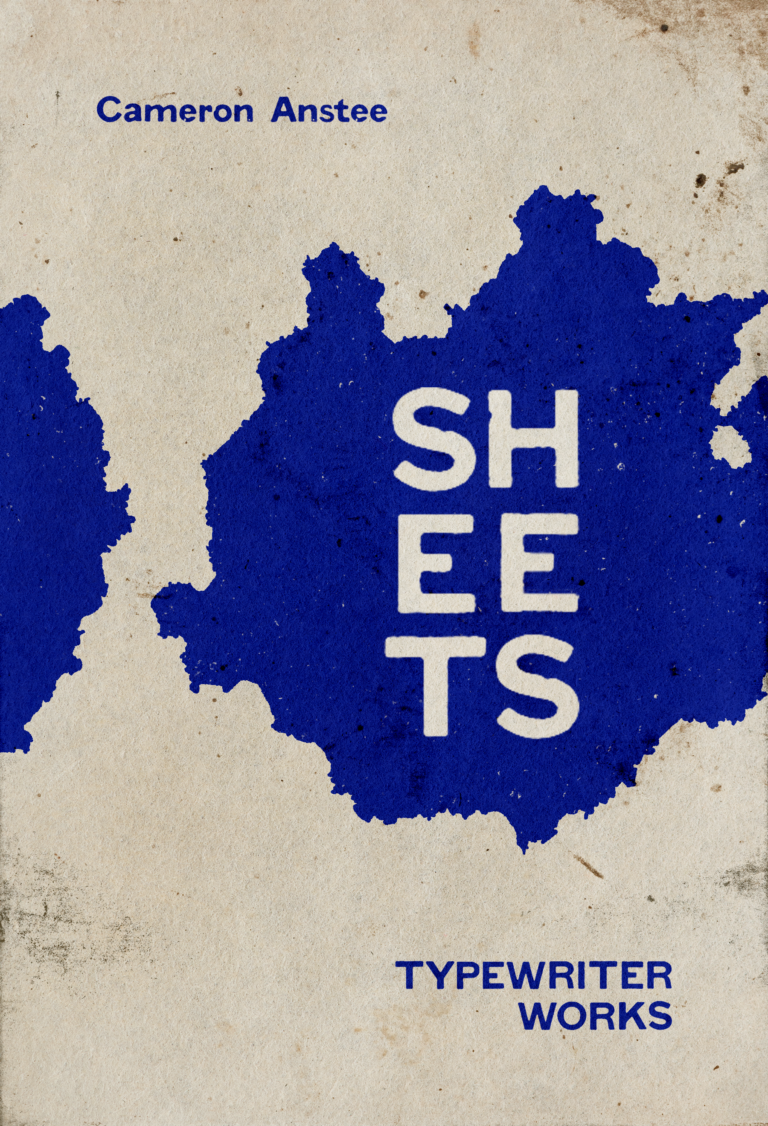The opening epigraph sets the scene for this collection, endearingly crooked, the text of it veering wildly upwards and to the right: “THE MOST DIFFICULT PART ABOUT TYPING IS GETTING THE PAPER IN STRAIGHT.”

From the jump, then, we are reminded that the poem is tactile, and the context of its production is only ever tactile. Here, the physical creation of the text is not obscured, as it is in most finished books these days, but instead called out, made visible.
Having shown us the foundation of constraints—the text dependent on paper, ink, and the tiny fallible arms of each typewriter letter—Anstee sets out to explore how these constraints can be bent, broken, undermined. Even when constraints cannot be circumvented—North American typewriters are overwhelmingly tied to the roman alphabet, for instance—they can be reimagined as possibilities for play. The whole book is dedicated to this kind of play, this kind of transformation, even a kind of defamiliarization.
We see this in an especially playful way in “Ellipsis (lowercase)” and “Ellipsis (uppercase)”: two poems, that are, seemingly, exactly the same—three periods typed and blown up to a half inch or so. Each period is distinctly unique, its rough edges and distortions made clear by their enlargement, and yet each period is also the same as the one before, typographically speaking, and communicates the same meaning. In Anstee’s hands, the mark becomes more and less than it is: a diagram, an illustration, a distillation of meaning. Usually, letters are thought of as part of larger formations: words, sentences, books. Here, though, Anstee’s play seems to centre on a different kind of question: what can we (re)build when the code is stripped away and letters and punctuations become merely marks?
And, in another playful sense, the whole book is perfumed with palimpsest in an expansive and exploratory way. Take Anstee’s first experimental section, titled “rehearsal,” which plays with inscribing and resinscribing the words once and once again. The words are pushed into the page so deeply that they become unintelligible, then their layers separated so it feels like a chorus speaking out of tandem. Each iteration seems to impart some different sense—a different tone, a different emphasis, a different kind of play.
Or, in perhaps the best palimpsestic example, take the plump middle section titled “Ottawa Poems,” filled with poems that are mostly x-ed out. The original source text, as the book’s afterword tells us, comes from poet William Hawkins’ collection of the same name published in 1966—the same poet who bequeathed Anstee the typewriter on which he retyped and over-typed these poems to create something new. The original poems can still be read if the reader is willing to strain towards a magic-eye picture kind of ocular dissociation, but the words left unexcoriated produce new narratives, injecting a secretive slowness into the source text. The resulting poem-within-poem feels a bit like stargazing: making new meaning from the points of light blazing back at you in a practice that feels ancient, familiar, and in some senses almost arcane—an alchemical transformation from one solid thing into another. Anstee presents the fruits of this labour, play and palimpsest in this book, and his reticence to call them poems—the front cover labels them, coolly, as typewriter works—is a further invitation to the reader. What meaning can be made here? Anstee asks, although not in so many words. What can we make from constraint, and from grief, and from the words of those around us? Sheets is, ultimately, a reminder of just that: nothing exists in isolation, and nor should it. This is clear in Anstee’s riffing on other poets, and the defamiliarized symbols made into entirely new images on the page, but also in the way the reader is invited to decide for themselves: is this poetry? And what is it doing? This, I think, is the idea at the heart of poetry as a whole—the collaborative creation of meaning. And it is, especially, something at which Sheets excels.
Bios
Dessa Bayrock
Dessa Bayrock lives in Ottawa with two cats and a variety of succulents, one of which occasionally blooms. She is the poetry editor at Shrapnel Magazine and was the recent winner of the Diana Brebner Prize. You can find her, or at least more about her, at dessabayrock.com, and at @yodessa on Twitter. [provided November 2023]

